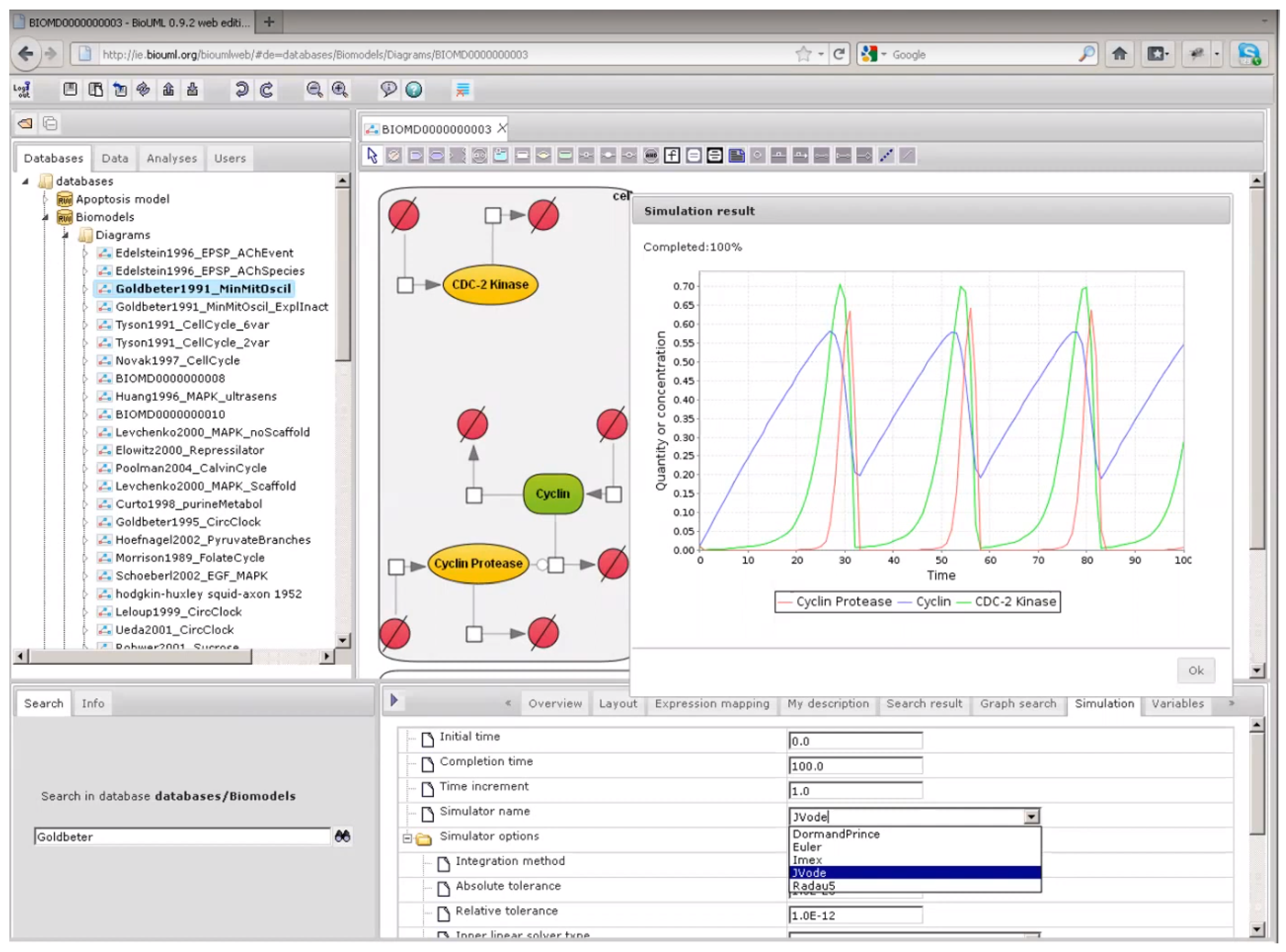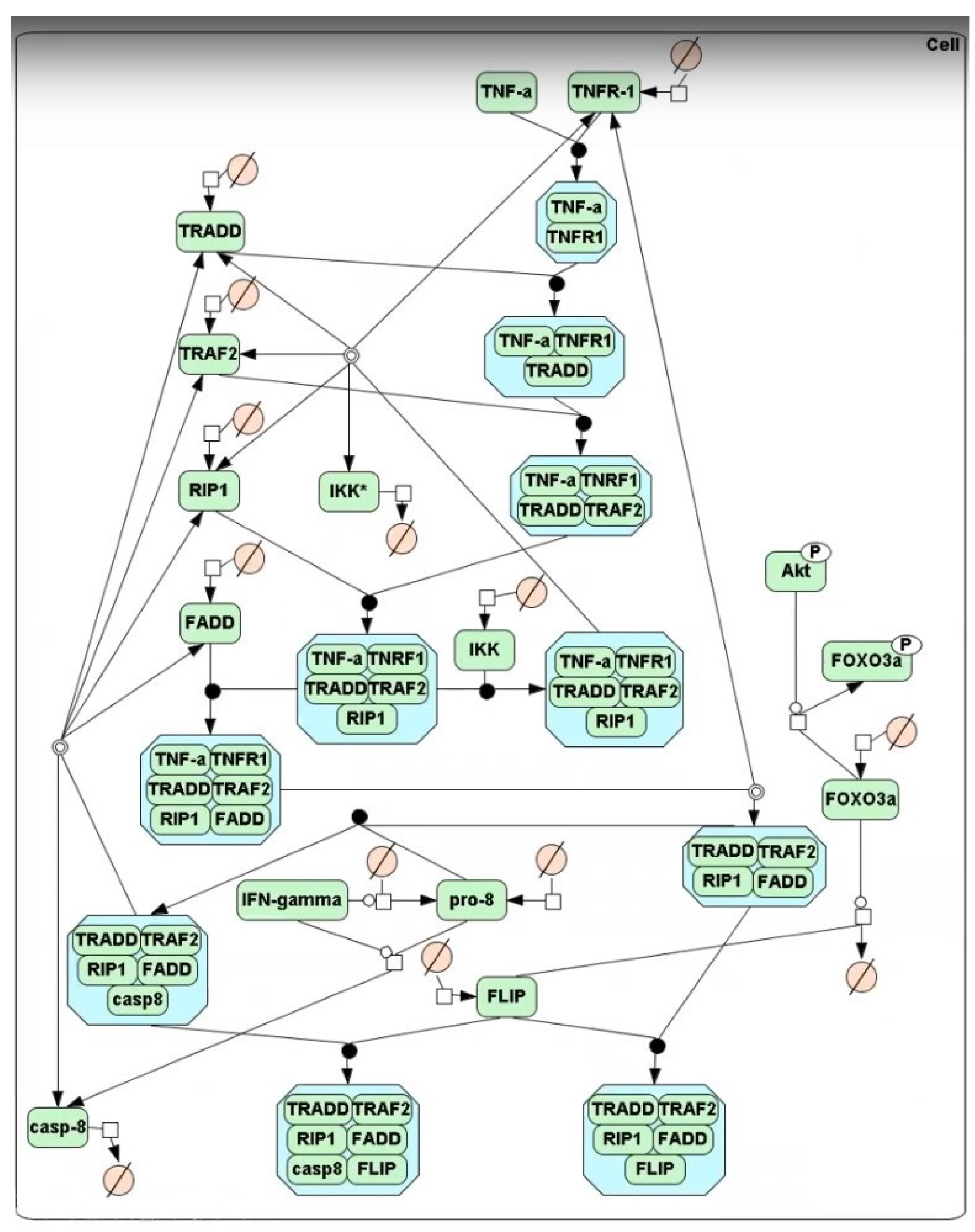Robust System of Algorithms for the Functioning of Biocompatible Artificial Liver Devices †
Abstract
1. Main Text
- 1.
- How to maintain a large cell mass without restrictions on the substrate so that the cells function with maximum efficiency;
- 2.
- How to maintain high levels of stable, long-term, liver-specific function in an artificial (and potentially inhospitable) environment;
- 3.
- How to minimize the amount of filling (or dead space) that needs to be filled with the patient’s blood or plasma.
2. Considering One of the Languages of Systems Biology
- 1.
- Computer programs whose main function is data analysis and visualization. For example, Docker is an open source project to automate the deployment of applications in the form of portable standalone containers running in the cloud or on premises. Common Workflow Language (CWL) is a specification for describing the analysis of workflows and tools in such a way as to make them portable and scalable in a variety of software and hardware environments, from workstations to clusters, the cloud, and high-performance computing environments (HPC).
- 2.
- The BioUML platform acts as the core [1], which acts as a link with integrated tools (Galaxy, Jupyterhub, R, Docker, noVNC, etc.).
- 3.
- IT infrastructure. This means the one on which the platform is installed.
- 4.
- External resources are connected via a special API. They are necessary for storing user data.
3. Conclusions
Author Contributions
Funding
Institutional Review Board Statement
Informed Consent Statement
Data Availability Statement
Conflicts of Interest
References
- Berthiaume, F.; Chan, C.; Yarmush, M.L. Liver, Bio-Artificial; Massachusetts General Hospital, Harvard Medical School, and the Shriners Hospital for Children: Boston, MA, USA, 2008. [Google Scholar]
- Tandon, R.; Froghi, S. Artificial liver support systems. J. Gastroenterol. Hepatol. 2020, 36, 1164–1179. [Google Scholar] [CrossRef] [PubMed]
- Bikhchandani, J.; Metcalfe, M.R.; Illouz, F.R.; Puls, F.; Path, F.R.; Dennison, A. Extracorporeal Liver Perfusion System for Artificial Liver Support Across a Membrane. J. Surg. Res. 2011, 171, e139–e147. [Google Scholar] [CrossRef] [PubMed]
- Alves, L.A.; Bonavita, A.; Quaresma, K.; Torres, E. New Strategies for Acute Liver Failure: Focus on Xenotransplantation Therapy. Cell Med. Part B Cell Transplant. 2010, 1, 47–54. [Google Scholar] [CrossRef] [PubMed][Green Version]
- Abouna, G.M.; Boehmig, H.G.; Serrou, B.; Amemiya, H.; Martineau, G. Long-term hepatic support by intermittent multi-species liver perfusions. Lancet 1970, 2, 391–396. [Google Scholar] [CrossRef] [PubMed]
- Court, F.G.; Wemyss-Holden, S.A.; Dennison, A.R. Bioartificial liver support devices: Historical perspectives. ANZ J. Surg. 2003, 73, 739. [Google Scholar] [CrossRef] [PubMed]
- Kiley, J.; Welch, H. Removal of Blood Ammonia by Hemodialysis. Proc. Soc. Exp. Biol. Med. Publ. 1956, 1, 57. [Google Scholar] [CrossRef] [PubMed]
- Nakao, M.; Nakayama, N.; Uchida, Y. Nationwide survey for acute liver failure and late-onset hepatic failure in Japan. J. Gastroenterol. 2017, 53, 752–769. [Google Scholar] [CrossRef] [PubMed]
- Martínez, J.J.G.; Bendjelid, K. Artifcial liver support systems: What is new over the last decade. Ann. Intensive Care 2018, 8, 109. [Google Scholar] [CrossRef] [PubMed]
- Huang, S.; Hu, D.; Yuan, S. The Serum Metabolomics Study of Liver Failure and Artificial Liver Therapy Intervention. Med. Sci. Monit. Int. Med. J. Exp. Clin. Res. 2021, 27, e930638. [Google Scholar] [CrossRef] [PubMed]
- Bloem, R.; Greimel, K.; Henzinger, T.A. Synthesizing Robust Systems. Acta Inform. 2009, 51, 193–220. [Google Scholar] [CrossRef]
- Kolpakov, F.; Akberdin, I.; Kashapov, T.; Kiselev, L.; Kolmykov, S.; Kondrakhin, Y.; Kutumova, E.; Mandrik, N.; Pintus, S.; Ryabova, A.; et al. BioUML: An integrated environment for systems biology and collaborative analysis of biomedical data. Nucleic Acids Res. 2019, 47, W225–W233. [Google Scholar] [CrossRef] [PubMed]



Disclaimer/Publisher’s Note: The statements, opinions and data contained in all publications are solely those of the individual author(s) and contributor(s) and not of MDPI and/or the editor(s). MDPI and/or the editor(s) disclaim responsibility for any injury to people or property resulting from any ideas, methods, instructions or products referred to in the content. |
© 2023 by the authors. Licensee MDPI, Basel, Switzerland. This article is an open access article distributed under the terms and conditions of the Creative Commons Attribution (CC BY) license (https://creativecommons.org/licenses/by/4.0/).
Share and Cite
Ganshin, A.; Andrikov, D. Robust System of Algorithms for the Functioning of Biocompatible Artificial Liver Devices. Eng. Proc. 2023, 33, 62. https://doi.org/10.3390/engproc2023033062
Ganshin A, Andrikov D. Robust System of Algorithms for the Functioning of Biocompatible Artificial Liver Devices. Engineering Proceedings. 2023; 33(1):62. https://doi.org/10.3390/engproc2023033062
Chicago/Turabian StyleGanshin, Alexey, and Denis Andrikov. 2023. "Robust System of Algorithms for the Functioning of Biocompatible Artificial Liver Devices" Engineering Proceedings 33, no. 1: 62. https://doi.org/10.3390/engproc2023033062
APA StyleGanshin, A., & Andrikov, D. (2023). Robust System of Algorithms for the Functioning of Biocompatible Artificial Liver Devices. Engineering Proceedings, 33(1), 62. https://doi.org/10.3390/engproc2023033062





